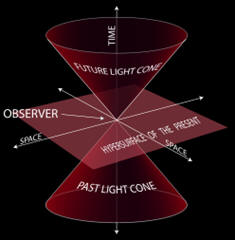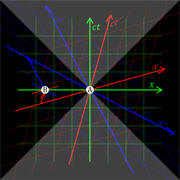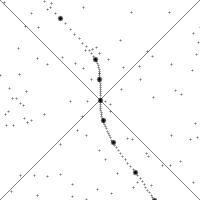Physical Definition of Time
| From the age of Newton up until Einstein's profound
reinterpretation of the physical concepts associated with time
and space, time was considered to be "absolute" and to flow
"equably" (to use the words of Newton) for all observers. The
science of classical mechanics is based on this Newtonian idea
of time. Einstein, in his special theory of relativity, postulated the constancy and finiteness of the speed of light for all observers. He showed that this postulate, together with a reasonable definition for what it means for two events to be simultaneous, requires that distances appear compressed and time intervals appear lengthened for events associated with objects in motion relative to an inertial observer. Einstein showed that if time and space is measured using electromagnetic phenomena (like light bouncing between mirrors) then due to the constancy of the speed of light, time and space become mathematically entangled together in a certain way (called Minkowski space) which in turn results in Lorentz transformation and in entanglement of all other important derivative physical quantities (like energy, momentum, mass, force, etc) in a certain 4-vectorial way.
Modern physicsIn the late nineteenth century, physicists encountered problems with the classical understanding of time, in connection with the behavior of electricity and magnetism. Einstein resolved these problems by invoking a method of synchronizing clocks using the constant, finite speed of light as the maximum signal velocity. This led directly to the result that observers in motion relative to one another will measure different elapsed times for the same event.
Einstein (The Meaning of Relativity): "Two events taking place at the points A and B of a system K are simultaneous if they appear at the same instant when observed from the middle point, M, of the interval AB. Time is then defined as the ensemble of the indications of similar clocks, at rest relatively to K, which register the same simultaneously." Einstein wrote in his book, Relativity, that simultaneity is also relative, i.e., two events that appear simultaneous to an observer in a particular inertial reference frame need not be judged as simultaneous by a second observer in a different inertial frame of reference. Relativistic time versus Newtonian time
In the figures, the vertical direction indicates time. The horizontal direction indicates distance (only one spatial dimension is taken into account), and the thick dashed curve is the spacetime trajectory ("world line") of the observer. The small dots indicate specific (past and future) events in spacetime. The slope of the world line (deviation from being vertical) gives the relative velocity to the observer. Note how in both pictures the view of spacetime changes when the observer accelerates. In the Newtonian description these changes are such that time is absolute: the movements of the observer do not influence whether an event occurs in the 'now' (i.e. whether an event passes the horizontal line through the observer). However, in the relativistic description the observability of events is absolute: the movements of the observer do not influence whether an event passes the "light cone" of the observer. Notice that with the change from a Newtonian to a relativistic description, the concept of absolute time is no longer applicable: events move up-and-down in the figure depending on the acceleration of the observer. Arrow of timeTime appears to have a direction – the past lies behind, fixed and incommutable, while the future lies ahead and is not necessarily fixed. Yet the majority of the laws of physics don't provide this arrow of time. The exceptions include the Second law of thermodynamics, which states that entropy must increase over time; the cosmological arrow of time, which points away from the Big Bang, and the radiative arrow of time, caused by light only traveling forwards in time. In particle physics, there is also the weak arrow of time, from CPT symmetry, and also measurement in quantum mechanics.Quantized timeTime quantization is a hypothetical concept. In the modern established physical theories (the Standard Model of Particles and Interactions and General Relativity) time is not quantized.Planck time (~ 5.4 × 10−44 seconds) is the unit of time in the system of natural units known as Planck units. Current established physical theories are believed to fail at this time scale, and many physicists expect that the Planck time might be the smallest unit of time that could ever be measured, even in principle. Tentative physical theories that describe this time scale exist; for instance loop quantum gravity. Time and the Big BangStephen Hawking in particular has addressed a connection between time and the Big Bang. In A Brief History of Time and elsewhere, Hawking says that even if time did not begin with the Big Bang and there were another time frame before the Big Bang, no information from events then would be accessible to us, and nothing that happened then would have any effect upon the present time-frame. Upon occasion, Hawking has stated that time actually began with the Big Bang, and that questions about what happened before the Big Bang are meaningless. This less-nuanced, but commonly repeated formulation has received criticisms from philosophers such as Aristotelian philosopher Mortimer J. Adler.Scientists have come to some agreement on descriptions of events that happened 10−35 seconds after the Big Bang, but generally agree that descriptions about what happened before one Planck time (5 × 10−44 seconds) after the Big Bang will likely remain pure speculation. Speculative physics beyond the Big Bang
While the Big Bang model is well established in cosmology, it
is likely to be refined in the future. Little is known about the
earliest moments of the universe's history. The Penrose-Hawking
singularity theorems require the existence of a singularity at
the beginning of cosmic time. However, these theorems assume
that general relativity is correct, but general relativity must
break down before the universe reaches the Planck temperature,
and a correct treatment of quantum gravity may avoid the
singularity. |





